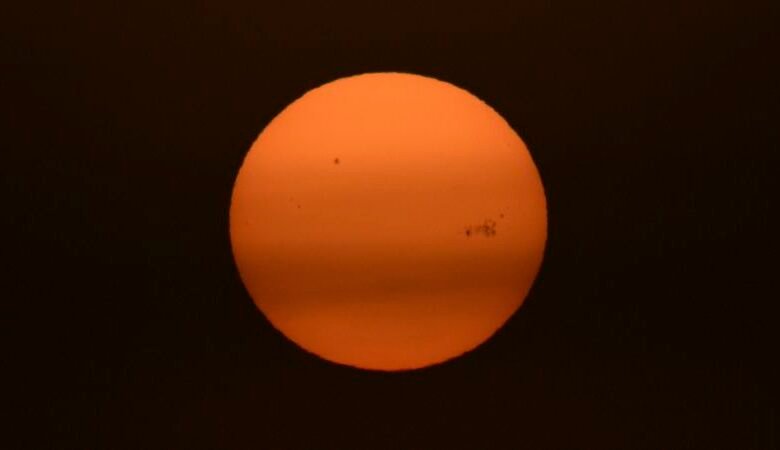Why Tonight’s Massive Solar Storm Could Disrupt Communications and GPS Systems

Programming Note: Tune into CNN NewsNight: Solar Storm, hosted by Abby Phillip and Bill Weir, tonight from 10pm to 12pm ET. For the latest on the massive solar storm, go to CNN’s live coverage.
washington
CNN
–
Buckle up: An unusual amount of solar activity this week could disrupt some of the most important technologies on which society depends.
On Thursday, the US government issued its first geomagnetic storm watch in nearly 20 years, warning the public about “at least five Earth-directed coronal mass ejections” as well as sunspots covering an area 16 times larger than Earth itself. A severe geomagnetic storm, or G4, is the second highest degree in the U.S. government’s classification system.
Radiation from this activity began reaching Earth’s magnetic field on Friday and will last through the weekend, the National Oceanic and Atmospheric Administration (NOAA) said. On Friday night, NOAA upgraded the storm to G5, or “extreme,” marking the first such event since October 2003.
NOAA’s warning about extreme space weather suggests the storm could trigger numerous effects for life on Earth, possibly affecting the electrical grid as well as satellite and high-frequency radio communications. See what this means for technology users.
The solar activity NOAA is talking about involves the release of energy from the sun that travels through space and eventually reaches Earth.
When this radiation reaches the magnetic sphere that surrounds the planet, it causes fluctuations in the ionosphere, a layer of the upper atmosphere.
These changes can directly affect satellites and other spacecraft in orbit, altering their orientation or potentially disabling their electronic components.
Additionally, changes in the ionosphere can block or degrade radio transmissions trying to pass through the atmosphere to reach satellites. And they can also prevent radio transmissions from being successfully reflected in the ionosphere – which some radio operators typically do to increase the range of their signals.
Since GPS satellites rely on signals that penetrate the ionosphere, the geomagnetic disruption that scientists expect could affect this critical technology used by airplanes, ocean-going ships, and in the agriculture and oil and gas industries. And it could affect shortwave radio transmissions used by ships and aircraft, emergency management agencies, militaries and even amateur radio operators, all of whom rely on high-frequency radio waves that NOAA says could be scattered by the storm.
Costfoto/NurPhoto/AP
The sun is rising brightly over Korla, Xinjiang Uyghur Autonomous Region, China, on May 10, 2024.
“Geomagnetic storms can impact infrastructure in near-Earth orbit and at the Earth’s surface, potentially disrupting communications, the electrical power grid, navigation, radio and satellite operations,” said the Space Weather Prediction Center of NOAA in a statement. “SWPC has notified the operators of these systems so they can take protective measures.”
Consumer wireless networks rely on radio frequencies other than the high-frequency band, so it seems unlikely that the storm will directly affect cellular service. Your phone’s GPS features also often use a combination of pure GPS and cell tower-based location tracking, so even if GPS signals are interrupted, phone users will still be able to maintain an approximate location.
As long as the underlying electrical infrastructure supporting wireless networks remains unchanged, even an extreme space weather event should result in “minimal direct impact on public safety, radio line of sight, and commercial cellular services… and no first-time impact.” order in consumer electronic devices”. ,” according to researchers summarizing findings from a 2010 study on extreme space weather conducted by NOAA and the Federal Emergency Management Agency.
The Cybersecurity and Infrastructure Security Agency described a similar report in a 2021 presentation on space weather, concluding that line-of-sight radio transmissions are generally not affected by space weather except in specific situations. The presentation noted some risks for copper cables and land-based telephone lines.
In a slightly different scenario in February, NOAA noted two large solar flares. But despite “widely reported cellular network outages” around the same time, the agency said, it was “highly unlikely” that explosions played a role in those blackouts.
On Friday, NOAA officials reiterated that the impact on cell phones this weekend should be reduced to none unless there are major outages on the power grid.
“We have not seen any evidence in the past that a space weather storm could impact this now,” Brent Gordon, head of SWPC’s Space Weather Services branch, told reporters on a conference call. “If the energy is not available to them, then yes, certainly, the secondary impacts of that would be large.”
Severe space weather could compromise power grids, according to NOAA, whose warning this week said it expected “possible widespread voltage control problems” and that “some protection systems could mistakenly trip important power grid assets.”
In 1989, a space weather event led to a massive blackout in Quebec, Canada, lasting more than nine hours after geomagnetic fluctuations damaged transformers and other important equipment.
In October, an extreme geomagnetic storm stronger than expected for this weekend led to power outages in Sweden and damaged power transformers in South Africa, the SWPC said.
The largest known geomagnetic storm in history, known as the Carrington Event of 1859, caused telegraph stations to ignite and catch fire.
A power grid blackout could have cascading effects on communications and other technologies, including cell phones. Cell towers can lose power, as can data centers that host websites and their information.
Still, many wireless carrier providers already maintain backup power generators and mobile cell towers that can be deployed in the event of a natural disaster or other serious incident. Redundancy and resilience are watchwords for all critical infrastructure providers, so even if the power grid fails, consumers may have to worry more about keeping their phones charged than whether they can stay online.
As if to underline this point, the US government’s advice to the public on how to prepare for a space weather event largely resembles the same steps you would take in response to a prolonged power outage.
For example, the government recommends keeping extra batteries or a handheld charger on hand for small electronic devices. Officials say you may want to unplug electrical appliances to protect them from power surges and limit electricity use during a solar weather event. You can also keep your car’s gas tank at least half full so you don’t have to go to a gas station (which needs electricity to run the pumps).
CNN’s Ashley Strickland contributed to this report.




